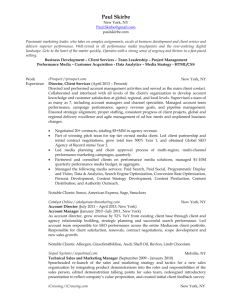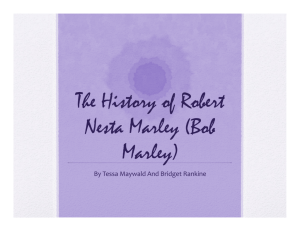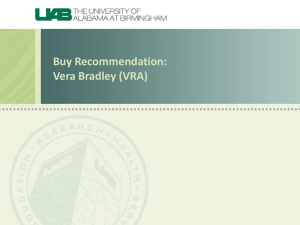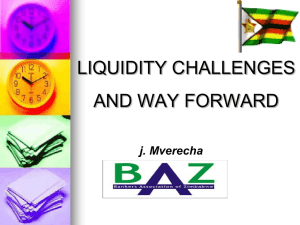Lesson Plan
advertisement
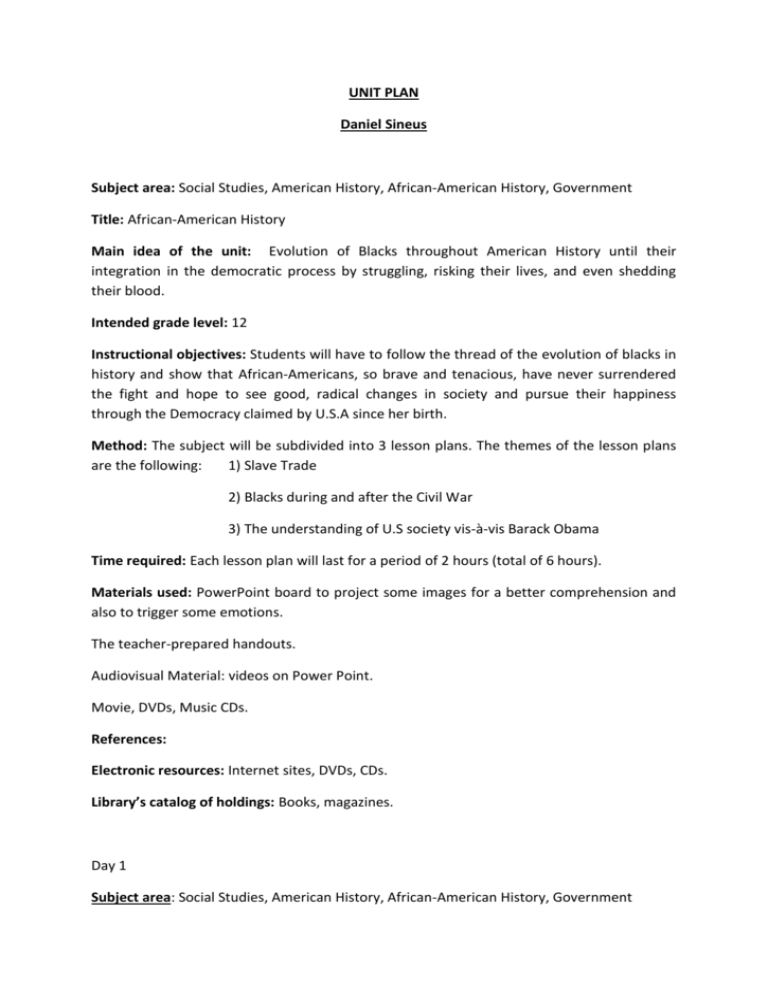
UNIT PLAN Daniel Sineus Subject area: Social Studies, American History, African-American History, Government Title: African-American History Main idea of the unit: Evolution of Blacks throughout American History until their integration in the democratic process by struggling, risking their lives, and even shedding their blood. Intended grade level: 12 Instructional objectives: Students will have to follow the thread of the evolution of blacks in history and show that African-Americans, so brave and tenacious, have never surrendered the fight and hope to see good, radical changes in society and pursue their happiness through the Democracy claimed by U.S.A since her birth. Method: The subject will be subdivided into 3 lesson plans. The themes of the lesson plans are the following: 1) Slave Trade 2) Blacks during and after the Civil War 3) The understanding of U.S society vis-à-vis Barack Obama Time required: Each lesson plan will last for a period of 2 hours (total of 6 hours). Materials used: PowerPoint board to project some images for a better comprehension and also to trigger some emotions. The teacher-prepared handouts. Audiovisual Material: videos on Power Point. Movie, DVDs, Music CDs. References: Electronic resources: Internet sites, DVDs, CDs. Library’s catalog of holdings: Books, magazines. Day 1 Subject area: Social Studies, American History, African-American History, Government Title: African-American History Concept/Main Idea of Lesson: The history of black people in America chiefly found its genesis in the Trans-Atlantic slave trade, which is critically important to examine with the students. Students will become acquainted with African-Americans’ origin in order to have self-consciousness by knowing the history of their ancestors and non-African-Americans will also develop an empathy and an appreciation for African-American History. Intended level grade: 12 Time required: A two-hour class period plus additional homework. Instructional objectives: Students will probe this part of history that irrefutably marked the history of the United States. They will learn two basic things: the origin of slave trade, and the vile conditions of the enslaved blacks. Learning Activities Sequence: A) Anticipatory set: The teacher will display some historical images out of chronological sequence on PowerPoint board and then ask the students to pair up in order to discuss how they are going to put these images in chronological order. Click on this link: images out of chronological sequence.docx b) Learning Activities Sequence It’s mandatory to provide the students with didactic materials in advance, such as handouts including essays (see resources 4 and 5) and lyrics of the songs Redemption song and buffalo soldier.doc, movies DVDs, music CDs or internet links. Learning activities: The students should read before-hand the essays, watch the movies recommended, and listen to the songs as an anticipated contact with the topic that is going to be taught in the following day. The teacher will lecture right after the anticipatory set. The teacher will take 30 minutes to have the students comment on the music and expect them to say to what extent the songs (redemption song and buffalo soldier) fit the History of Slave Trade (see resources 4 and 6). The following questions they will be asked are: What is the song about? Identify the historical terms used in the song in order to say how it fits the story they say the song is about. c) Closure: Put the pictures of slavery back on board, ask the students to express their thoughts and their feelings by answering this following question: Imagine if you were being led away to be sold like animals, what would be going through your mind? Assessments: The students will have to work on the movies (Amistad) as homework. The teacher has a relegated priority for the students to fulfill in order to enhance their writing skills and their ability to analyze a movie. This evaluation was built according to the narrative theory used for novels, which they have already mastered in their literature class. For this achievement, they will answer this set of questions: 1. Who are the main characters? 2. Describe the main characters by their actions. 3. Who is the hero?/ why? 4. Who is the antagonist?/ why? 5. What is the intrigue? 6. What is the denouement? 7. Write a synopsis about the movie. 8. Who wrote the movie and directed it? Materials and resources: Music CDs, songs: Buffalo Soldier/Redemption Song, by Bob Marley. Internet link: www.pandora.com Allen, D., Spielberg, S., and Wilson, C. (Producers). Franzoni, D. (Writer). (1997). Amistad. United States: DreamWorks pictures, HBO pictures. Anonymous. (2008). Origin of Slavery. History.com: Black History Video. Accessed on July 21, 2009 from < http://www.history.com/content/blackhistory> Anonymous. The African Slave Trade and The Middle passage. Africans in America. Accessed on July 23, 2009 from <http://www.pbs.org/wgbh/aia/part1/1narr4.html> Bodleian Library, university of Oxford (2007). The Slave Trade. Oxford: Bodleian library. Chomsky, M., J., Erman, J. (Producers). Blinn, W. (Writer). (1977). United States: David L. Woper Production. Direction of The Representatives Of The Religious Society Of Friends (1851). An Exposition Of The African Slave Trade. New York : AMS PRESS. Reynolds, Edward. (1985). Stand The Storm. Chicago: Elephant paperbacks. Walvin, James. (1983). Slavery and the Slave Trade. Jackson: University Press of Mississippi Wikipedia, the Free Encyclopedia. Slavery in the United States. Wikipedia. Accessed on july 19, 2009 from <http://en.wikipedia.org/wiki/Slavery_in_the_United_States> Day 2 Subject area: Social Studies, American History, African-American History, Government Title: African-American History Concept/Main Idea of Lesson: Present an overview that will shed light on the fact that African-American History is not cyclical but progressive by taking into account some events, during and after the American Civil War, regarded as watershed for blacks to cut off their bonds from slavery. On the other hand, some atrocious events show their consistent bravery to struggle hopefully and pacifically for their civic participation. This highlight on some turning points in African-American History will span from 1861 to 1960. Intended level grade: 12 Time required: A two-hour class period plus additional homework. Instructional objectives: On a whole, the students will have to follow the thread of blacks’ evolution in a society which withholds from them the rights to democracy. They will examine the heroic prowess African-Americans achieved some days ago so that Blacks, in America, can be what they are today. The students must be able to internalize some magnanimous attitudes African-Americans had portrayed during their endlessly pacific battle to enjoy a bit of democracy. To aim these targets, they will analyze with the teacher the greatest components in U.S History that led the Negroes to different movements in their history to overcome and break through respectively the maneuvers and the blockade of the Whites to keep them from enjoying democracy freely and freely. The topic events are American civil War, 13th amendment 14th amendment, 15th amendment, Jim Crow Laws, Harlem renaissance, NAACP, March on Washington. It’s more than convenient for the teacher to briefly address these events on this lesson plan in order to cover the objectives planned. Procedures/Learning Activities Sequence: It’s compulsory to provide the students with didactic materials in advance, such as handouts, movie DVDs, and internet links about documentaries and images. Learning activities: The students should read (see resources 2, 7, 8, 10), watch the movie (Glory) recommended, and visualizes the documentaries and the images (see resources) on the internet as an anticipated acquaintance with the topic that is soon going to be taught. During the lecture, the teacher will present a set of images relevant to the historical fact being taught. Closure: The teacher will debrief the lesson by asking students to answer the following questions: what did you learn from the history class today? What did you like and dislike in African-American History? Assessments: The students will have to work on a movie (Glory) as homework at a more academic level by using narrative theory. By doing so, the students will interiorize some historical contents related to Civil War. Whoever is going to use this evaluation should know this theory well; see Branigan, Edward. (1992). Narrative Comprehension and Film. London; New York: Routledge. (pp 17-18). Evaluation: (1). the student will do the best of their abilities to fill out the chart and show understanding of the narrative schema used to analyze films and equally the contents of the lesson plan. The teacher has a relegated priority for the students to fulfill in order to enhance their writing skills and their sense of analysis of a movie. The historical content of the movie deals with Blacks joining the army and fighting in the American Civil War. It will facilitate learning by activating the affective component of learning. A note for the teacher: Narrative is a recursive organization of data, that is, its components can be embedded successively at various micro-and macro-levels of action. The schema may contain the following eight components or functions which may be repeated in various patterns to model our understanding of a given story. An abstract is a title or compact summary of the situation which is to follow. If an abstract is expanded, it becomes a prologue. An orientation is a description of the present state of affairs (place, character, time) while an exposition gives information about the past events which bear on the present. An initiating event alerts the present state of affairs. A narrative which delays orientation and exposition and begins with an initiating event, or a complicating action. A goal is a statement of intention or an emotional response to an initiating event by a protagonist. A complicating action (linked to an antagonist) arises as a consequence of the initiating event and presents an obstacle to the attainment of the goal. The climax and resolution end the conflict between goals and obstacles and establish a new equilibrium or state of affairs. The epilogue is the moral lesson implicit in the history of these events and may include explicit character reactions to the resolution. NARRATIVE THEORY FOR ANALYZING FILMS The Orientation Exposition The Goal The Complicating action The Protagonist The Antagonist The Initiating Event The Epilogue Role-playing: (2). The teacher will require a role-playing activity. Six students will volunteer to carry out this learning strategy. Their task will be divided according to the figure they want to represent. These great figures are Martin Luther King Jr., Malcom X, Marcus Garvey, black soldiers at the time of Civil War, Zora Nearle Hurston, a Harlem Renaissance dancer, a singer of Harlem Renaissance. The students will volunteer to represent Martin Luther King; some will have to echo some of his famous civil rights speeches, some will present him as a pastor, and others will present him on a basis of discrimination. Those who choose to emulate the Civil War black soldiers will somewhat get dressed in a military way in blue and try to keep a posture of a soldier and express certain words that can testify how they could be so proud to fight for their citizenship. Some female students will represent Zora Nearle Hurston by declaiming some of her poetry, others will talk about her views about folklore. Some students will imitate from head to toe the way they used to dance in giving him some documentaries about how dancing at that time. Lastly, some students will sing a jazz song or a blues song of a singer of their choice. Students have choice to do either evaluation 1 or role-playing. Resources: Anonymous. (2009). 1965 Civil Rights March. (Photograph). Pacific Northwest. Labor and Civil Rights Project. Accessed on July 28, 2009 from <http://depts.washington.edu/labhist/pnwlabor> Anonymous. The Civil War and Emancipation. Africans in America. Accessed on July 23, 2009 from http://www.pbs.org/wgbh/aia/part4/4p2967.html Branigan, Edward. (1992). Narrative Comprehension and Film. London; New York: Routledge. (pp 17-18) Curtis, M. k. (1986). No State Shall Abridge: the fourteenth amendment and the bill of rights. Durham, North Carolina: Duke University Press. Du Bois, W.E.B. (2005). The Souls of Black Folk. New York: Pockets Books. Harlem Renaissance. Accessed on July 23, 2009 from <http://www.tesd.k12.pa.us/stoga/dept/Barry/Barry4/music/Harlem%20Renaissance%20Musi c%20page.htm> March on Washington, The Harlem Renaissance, Malcom X. (2008). History.com: Black History Video. Accessed on July 21, 2009 from < http://www.history.com/content/blackhistory> March on Washington, The Harlem Renaissance, and Malcom X. (2008). History.com: Black History Video. Accessed on July 21, 2009 from < http://www.history.com/content/blackhistory> Martin Luther King Jr., National Historic Site, Interpretive Staff. Examples of Jim Crow Laws. The University of Dayton School of Law. Accessed on July 23, 2009 from <http://academic.udayton.edu/Race/02rights/jcrow02.htm> Pilgrim, David. (2000). What Was Jim Crow? Ferris State University. Accessed on July 23, 2009 from <http://www.ferris.edu/news/jimcrow/what.htm> Weidman, Budge. (1997). Teaching With Document: the Fight For Equal Rights: Black Soldiers in The Civil War. Archives.gov. Accessed on July 23, 2009 from <http://www.archives.gov/education/lessons/blacks-civil-war/article.html> Wikipedia, The Free Encyclopedia. Harlem Renaissance. Wikipedia. Accessed on July 23, 2009 from < http://en.wikipedia.org/wiki/Harlem_Renaissance> Zwick, Edward. (Director). Shaw,R.G. (Writer). (1989). Glory. United States: TriStar Pictures. Day 3 Subject area: Social Studies Title: African-American History, Government Concept/Main Idea of Lesson: Highlight the public perception about Obama being President of United States. By doing so, the teacher should bring some insight on Obama’s dreams and background. Some factual information must be brought up to the students. First, depict the exhilarated feeling of a heap of red-blooded Americans who were dying to see this change Sam Cooke longed to see in his song entitled “Change Is Gonna come”. Secondly, the map of the presidential election poll is a necessary concern to reach basically the point where we can admit that there’s a change. Definitely, make a connection between the past African-American leaders with Obama whose victory stands on their shoulders. Intended level grade: 12 Time required: a two-hour class period Instructional objectives: The students will examine the map of the latest presidential election 2008 (see resources 3). They will become acquainted with some Blacks who dreamt what Obama dreams. They will report or comment how they witnessed Obama’s election by depicting some people’s joyfulness. They will know a little bit about the eventual causes that brought Obama into the White House. Procedures/ Learning Activities Sequence: It’s mandatory to provide the students with didactic materials in advance, such as handouts including essays (2, 4 and 5) and lyrics of the song Change is gonna come by Sam Cooke.docx, and music CD, before the lecture. Set induction/lesson Initiating Behavior: The teacher will get the students involved in a warm-up that consists of showing Obama’s picture to the students. The teacher will ask the students to identify the picture and then ask them to say whatever they know about this person. Learning Activities: Right after showing them the picture and having them discuss it, the teacher will play a song (Change is Gonna Come) and ask them to identify something similar with Obama’s slogans and ask them to make a difference between them according to their different contexts. After lecturing about the understanding of U.S society vis-à-vis Barack Obama, analyze the map of the 2008 presidential election, and get the students involved in a guessing game in which they will guess which candidate won certain states. To have them do that, here are the questions to answer: who won Ohio, McCain or Obama? Who won Minnesota? Who won Florida? And so on. The teacher will play a two or three-minute documentary video (see reference 1) for them about what Obama meant for this nation. Closure: Have the students to pair up and ask them to interview each other about Obama who is the first black president. The questions for the interview are: What does Obama’s victory in the election mean to you? What lesson of Democracy can somebody learn from this historically significant reality? The teacher will walk around to see if they are getting it done. Assessment: The teacher will give, as a post-evaluation, a unit test to the students so that he can appraise their acquisition. This unit test will focus on an objective assessment that comprises multiple choice, true-false questions, and short answer in order to measure what the students have learned on some points. The evaluation will be based on the 3 previous lessons and count as 30 percent for the exam. The answer sheet True-false questions 1- False (15th amendment ) 2- False (It’s true renaissance was an artistic and literary movement but never a violent movement. 3- False (Hurbet Harrison) 4- False (the slaves were leading a terrifying existence because of the inhuman treatment their slavemasters gave them. 5- true The answers of the multiple choice 12345- b a b b a Resources: Anonymous. (Nov. 12, 2008). American Optimistic About Obama Can Do. (video).Gallup.com. Accessed on July 27, 2009 from < http://www.gallup.com/video/111856/Many-ThinkObama-Administration-Will-Reduce-Unemployment.aspx> Cooke, Sam. (1951-64). Change Is Gonna Come. On Portrait Of A Legend. (CD). U.S.A Kottke.org.(2008). 2008. Election Map. Kottke.org. accessed on July 28, 2009 from <http://kottke.org/plus/2008-election-maps/> Nagourney, Adam. (Nov. 4, 2008). Obama Elected President As Racial Barrier Falls. The New York Times. Accessed on July 22, 2009 from <http://www.nytimes.com/2008/11/05/us/politics/o5elect.html?ref=politics> Sack, Kevin. (Nov. 4, 2008). A time to reap For Foot Soldiers Of Civil Rights. The New York Times. Accessed on July 22, 2009 from http://www.nytimes.com/2008/11/05/us/politics/05civil.html?ref=politics References: Obama, Barack. (2004). Dreams From My Father. New York: Crown Publisher. Obama, Barack. (2006). The Audacity Of The Hope. New York: Crown Publisher. Post-Evaluation True-false questions Read carefully each sentence and write true or false. (5 points) 1. __________14th amendment stated simply that the right of citizens of the United States to vote shall not be denied or abridged by United States or by any states on account of race, color, or previous conditions of servitude. 2. __________The Harlem renaissance was not a literary and artistic movement but a violent movement for liberty. 3. ____________In 1917, Frederick Douglass founded the liberty league, the first organization of the “New Negro Movement”. 4. ____________The slaves were unfairly treated by the slaveholders. 5. ____________The 15th amendment was the last of the “Reconstruction Amendment” to be adopted. Multiple choice Make a cross on the letter that fits the best the answer. (5 points) 1. Whose speech is this: “I urged you to fly to arms and smite with death the power that would bury the government and your liberty in the same hopeless grave? a) Zora Nearle Hurston b) Frederick Douglass c) Langston Hughes d) none 2. The first newspaper of new Negro movement is …. a) The Voice b) Ebony c) The Crisis magazine d) none 3. Whose speech is this: “I have a dream that one day on the red hills of Georgia the sons of former slaves and the sons of former slave owners will be able to sit down together at a table of brotherhood”. a) Malcolm X b) Martin Luther King c) Barrack Obama d) W.E.B du bois 4) What is the profession Barrack Obama? a) Doctor b) Lawyer c) Democrat d) Sociologist and Anthropologist 5. Which amendment Abraham Lincoln signed was destined to abolish the Slavery? a) 13th b) 20th c) 14th d) 15th d) none Short answer section You are to choose 2 out of these 3 questions and answer each as completely as you can. Each of these 3 questions is worth up to 10 points each. Give the possible reasons why Abraham Lincoln declared Blacks could join Army. Give at least 4 examples of Jim Crow Laws. Say the reasons why you might think Barrack Obama can be one of the greatest American presidents. Redemption Song by Bob Marley Old pirates, yes, they rob i; Sold I to the merchant ships, Minutes after they took i From the bottomless pit. But my hand was made strong By the and of the almighty. We forward in this generation Triumphantly. Wont you help to sing These songs of freedom? cause all I ever have: Redemption songs; Redemption songs. Emancipate yourselves from mental slavery; None but ourselves can free our minds. Have no fear for atomic energy, cause none of them can stop the time. How long shall they kill our prophets, While we stand aside and look? ooh! Some say its just a part of it: Weve got to fulfil de book. Wont you help to sing These songs of freedom? cause all I ever have: Redemption songs; Redemption songs; Redemption songs. --/guitar break/ --Emancipate yourselves from mental slavery; None but ourselves can free our mind. Wo! have no fear for atomic energy, cause none of them-a can-a stop-a the time. How long shall they kill our prophets, While we stand aside and look? Yes, some say its just a part of it: Weve got to fulfil de book. Wont you help to sing Dese songs of freedom? cause all I ever had: Redemption songs All I ever had: Redemption songs: These songs of freedom, Songs of freedom. Buffalo soldier Buffalo soldier, dreadlock rasta: There was a buffalo soldier in the heart of america, Stolen from africa, brought to america, Fighting on arrival, fighting for survival. I mean it, when I analyze the stench To me it makes a lot of sense: How the dreadlock rasta was the buffalo soldier, And he was taken from africa, brought to america, Fighting on arrival, fighting for survival. Said he was a buffalo soldier, dreadlock rasta Buffalo soldier in the heart of america. If you know your history, Then you would know where you coming from, Then you wouldnt have to ask me, Who the eck do I think I am. Im just a buffalo soldier in the heart of america, Stolen from africa, brought to america, Said he was fighting on arrival, fighting for survival; Said he was a buffalo soldier win the war for america. Dreadie, woy yoy yoy, woy yoy-yoy yoy, Woy yoy yoy yoy, yoy yoy-yoy yoy! Woy yoy yoy, woy yoy-yoy yoy, Woy yoy yoy yoy, yoy yoy-yoy yoy! Buffalo soldier troddin through the land, wo-ho-ooh! Said he wanna ran, then you wanna hand, Troddin through the land, yea-hea, yea-ea. Said he was a buffalo soldier win the war for america; Buffalo soldier, dreadlock rasta, Fighting on arrival, fighting for survival; Driven from the mainland to the heart of the caribbean. Singing, woy yoy yoy, woy yoy-yoy yoy, Woy yoy yoy yoy, yoy yoy-yoy yoy! Woy yoy yoy, woy yoy-yoy yoy, Woy yoy yoy yoy, yoy yoy-yoy yoy! Troddin through san juan in the arms of america; Troddin through jamaica, a buffalo soldier# Fighting on arrival, fighting for survival: Buffalo soldier, dreadlock rasta. Woy yoy yoy, woy yoy-yoy yoy, Woy yoy yoy yoy, yoy yoy-yoy yoy! Woy yoy yoy, woy yoy-yoy yoy, Woy yoy yoy yoy, yoy yoy-yoy yoy! /fadeout/ Change is gonna come by Sam Cooke I was born by the river in a little tent Oh and just like the river I've been running ever since It's been a long, a long time coming But I know a change gonna come, oh yes it will It's been too hard living but I'm afraid to die Cause I don't know what's up there beyond the sky It's been a long, a long time coming But I know a change gonna come, oh yes it will I go to the movie and I go downtown somebody keep telling me don't hang around It's been a long, a long time coming But I know a change gonna come, oh yes it will Then I go to my brother And I say brother help me please But he winds up knockin' me Back down on my knees Ohhhhhhhhh..... There been times that I thought I couldn't last for long But now I think I'm able to carry on It's been a long, a long time coming But I know a change gonna come, oh yes it will
